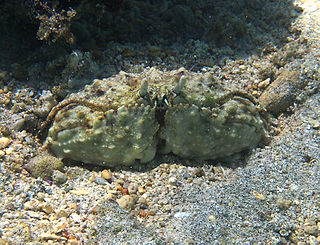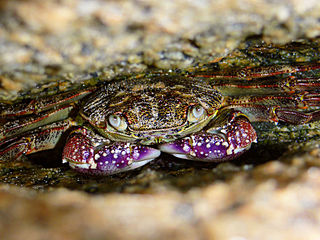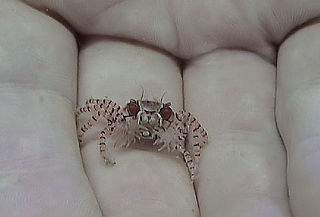
Henri Milne-Edwards was a French zoologist.

Xanthidae is a family of crabs known as gorilla crabs, mud crabs, pebble crabs or rubble crabs. Xanthid crabs are often brightly coloured and are highly poisonous, containing toxins which are not destroyed by cooking and for which no antidote is known. The toxins are similar to the tetrodotoxin and saxitoxin produced by puffer fish, and may be produced by bacteria in the genus Vibrio living in symbiosis with the crabs, mostly V. alginolyticus and V. parahaemolyticus.

Caridina is a genus of freshwater atyid shrimp. They are widely found in tropical or subtropical water in Asia, Oceania and Africa. They are filter-feeders and omnivorous scavengers. They range from 0.9 to 9.8 mm to 1.2–7.4 mm in carapace length.

Cancer is a genus of marine crabs in the family Cancridae. It includes eight extant species and three extinct species, including familiar crabs of the littoral zone, such as the European edible crab, the Jonah crab and the red rock crab. It is thought to have evolved from related genera in the Pacific Ocean in the Miocene.

Calappa is a genus of crabs known commonly as box crabs or shame-faced crabs. The name box crab comes from their distinctly bulky carapace, and the name shame-faced is from anthropomorphising the way the crab's chelae (claws) fold up and cover its face, as if it were hiding its face in shame.

Portunidae is a family of crabs which contains the swimming crabs. Its members include many well-known shoreline crabs, such as the blue crab and velvet crab. Two genera in the family are contrastingly named Scylla and Charybdis; the former contains the economically important species black crab and Scylla paramamosain.

Tuerkayana hirtipes is a species of terrestrial crab.

Macrophthalmus is a genus of crabs which are widespread across the Indo-Pacific. It contains the following species : Species in this genus are often referred to as sentinel crabs.

Leptograpsus variegatus, known as the purple rock crab, is a marine large-eyed crab of the family Grapsidae, found in southern subtropical Indo-Pacific Oceans. It grows to around 50 millimetres (2.0 in) shell width. It is the only species in the genus Leptograpsus.

Cancridae is a family of crabs. It comprises six extant genera, and ten exclusively fossil genera, in two subfamilies:

Palaemonidae is a family of shrimp in the order Decapoda. Many species are carnivores that eat small invertebrates, and can be found in any aquatic habitat except the deep sea. One significant genus is Macrobrachium, which contains commercially fished species. Others inhabit coral reefs, where they associate with certain invertebrates, such as sponges, cnidarians, mollusks, and echinoderms, as cleaner shrimps, parasites, or commensals. They generally feed on detritus, though some are carnivores and hunt tiny animals.

Johngarthia is a genus of crabs in the land crab family Gecarcinidae, formerly included in the genus Gecarcinus, and containing six species. The genus bears the name of John S. Garth, a 20th century naturalist who specialized in crabs and other arthropods.

Lybia is a genus of small crabs in the family Xanthidae. Their common names include boxer crabs, boxing crabs and pom-pom crabs. They are notable for their mutualism with sea anemones, which they hold in their claws for defense. In return, the anemones get carried around, which may enable them to capture more food particles with their tentacles. Boxer crabs use at least three species of anemones, including Bundeopsis spp. and Triactis producta. The bonding with the anemone is not needed for survival, however, and boxer crabs have frequently been known to live without them, sometimes substituting other organisms such as sponges and corals for the sea anemones.

Hexapodidae is a family of crabs, the only family in the superfamily Hexapodoidea. It has traditionally been treated as a subfamily of the family Goneplacidae, and was originally described as a subfamily of Pinnotheridae. Its members can be distinguished from all other true crabs by the reduction of the thorax, such that only seven sternites are exposed, and only four pairs of pereiopods are present. Not counting the enlarged pair of claws, this leaves only six walking legs, from which the type genus Hexapus, and therefore the whole family, takes its name. Some anomuran "crabs", such as porcelain crabs and king crabs also have only four visible pairs of legs. With the exception of Stevea williamsi, from Mexico, all the extant members are found either in the Indo-Pacific oceans, or around the coast of Africa.

Inachidae is a family of crabs, containing 39 genera:

Macropodia is a genus of crabs, belonging to the family Inachidae. It contains the following species:

Epialtinae is a subfamily of crabs, containing the following genera:

Pilumnus is a genus of crabs, containing the following species:

Pisinae is a subfamily of crabs in the family Epialtidae, comprising the following genera:
Naxia is a genus of crabs in the family Majidae, containing the following species:




















